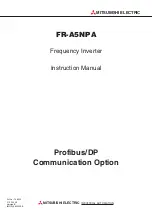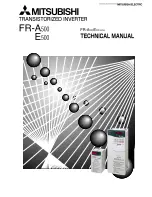
OPERATION
Control Options
67
Damper Control (HVAC Applications)
The VFD can provide a relay output to open a damper actuator before starting a fan motor. When enabled,
the damper relay output is activated when the system receives a
RUN
command and the motor will start
based on the following configurations:
•
With Damper Limit Switch:
If any Digital Input
[IO–21 through 28]
is set to
Damper Limit Sw
and the VFD
receives a
RUN
command, the damper relay is activated and when the damper limit switch is closed
(damper is fully open and DI is activated), the VFD will start the motor.
If the limit switch is not closed within the
Damper Time Delay [IO–37]
, the VFD will trip on Damper Fault. If
at any point during run mode damper limit switch is open for more than 2 seconds, the VFD will trip on
Damper Fault. VFD will try to restart based on the retry number setting
[PROT–41]
.
•
Without Damper Limit Switch.
If no Digital Input is configured for a damper limit switch and the VFD
receives a
RUN
command, the damper relay is activated and when
Damper Time Delay [IO–37]
is complete,
the VFD will start the motor. There is no damper fault detection because there is no damper limit switch
feedback.
NOTE:
If any other delay timer is set and the VFD receives a
RUN
command, the damper relay will start after
the first timer expires.
During run mode the damper relay stays activated. When a
STOP
command is received, the damper relay will
be deactivated only in VFD stop state. If stop mode is set to deceleration, the relay will be deactivated after
VFD reaches zero speed (0.00Hz).
Set the following parameters to use the Damper Control function:
Damper Mode [IO–36]:
This setting enables or disables damper mode. When enabled, the damper relay is
activated before every start, including auto restarts.
Damper T-Delay [IO–37]:
This setting provides a run time delay without a damper limit switch; or, provides
a Damper Fault delay for systems that include a damper limit switch. The delay should be greater than
damper opening time.
Damper Output Terminal [IO–47 through 49]:
Connect the damper actuator to one of the Relay Outputs
(RA1–3), and set the corresponding parameter to
38 Damper Output
.
Damper Limit SW Terminal [IO–21 through 28]:
If the system includes a damper limit switch, connect the
switch to one of the Digital Inputs (MI1–8) and set the corresponding parameter to
34 Damper Limit SW
.
Fireman’s Override
Fireman’s Override provides the ability to force the drive to run in an emergency situation.
In FO mode, if Damper Mode is enabled
[IO–36]
, the damper relay output will be activated, but damper time
delay
[IO–37]
will be reduced by half before VFD starts. The VFD will not monitor a Damper Switch, if present,
and no damper faults will be available. Set the following parameters to use the Fireman’s Override function:
FO Input Terminal [IO–21 through 28]:
Connect the Fireman’s Override switch to one of the Digital Inputs
(MI1–8) and set the corresponding parameter to either
32 FO with RUN Cmd
or
33 FO w/o RUN Cmd
.
FO Enable [IO–29]:
This setting enables Fireman’s Override in either Forward or Reverse.
FO Frequency [IO–30]:
Setpoint for non-PID operation during Fire Override.
FO Fault Retry [IO–31]:
Number of fault resets allowed during Fire Override.
FO Retry Delay [IO–32:
Delay until restart during Fire Override.
FO Mode & Reset [IO–33]:
Sets control method and reset method during Fire Override: PID Off Manual, PID
Off Auto, PID On Manual, or PID On Auto.
FO PID S-Point [IO–34]:
Setpoint for PID operation during Fire Override.
FO Bypass [IO–72]:
Enables Bypass for Fire Override.
FO Bypass Delay [IO–73]:
Time delay between Fire Override becoming active and enabling relay output.
Summary of Contents for Cerus X-Drive
Page 2: ......
Page 3: ...CERUS X DRIVE INSTALLATION AND OPERATION MANUAL Firmware Version 1 1 Franklin Electric Co Inc ...
Page 94: ...COMMUNICATIONS BACnet Communication 94 ...
Page 98: ...ACCESSORIES Optional Extension Cards 98 Frame D Frame E Frame F ...
Page 99: ...ACCESSORIES Optional Extension Cards 99 Frame G Frame H ...
















































